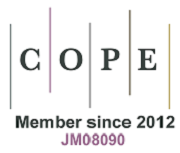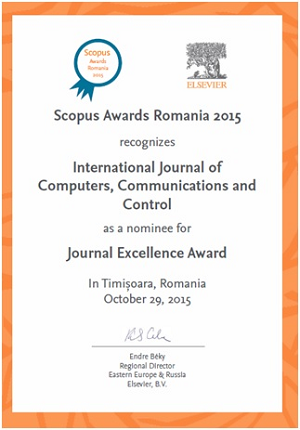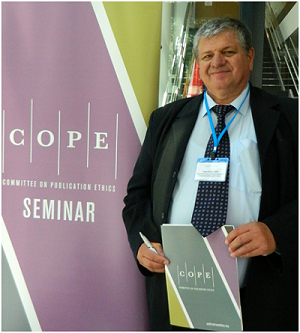Game Theoretic Distributed Power Control Algorithms for Uplink Wireless Data in Flat Fading Channels
Keywords:
Code-division-multiple-access (CDMA), utility function, power control, game theory, non-cooperative game (NPG), wireless dataAbstract
In this paper we present a game-theoretic power control algorithms for wireless data in CDMA cellular systems under two realistic channels: (a1) Fast flat fading channel and (a2) Slow flat fading channel. The fading coefficients under both (a1) and (a2) are studied for three appropriate small scale channel models that are used in the CDMA cellular systems: Rayleigh channel, Rician channel and Nakagami channel. This work is inspired by the results presented by [1] under nonfading channels. In other words, we study the impact of the realistic channel models on the findings in [1] through the followings: we evaluate the average utility function, the average number of bits received correctly at the receiver per one Joule expended, for each channel model. Then, using the average utility function we study the existence, uniqueness of Nash equilibrium (NE) if it exists, and the social desirability of NE in the Pareto sense. Results show that in a non-cooperative game (NPG) the best policy for all users in the cell is to target a fixed signal-to-interference and noise ratio (SINR) similar to what was shown in [1] for non-fading channel. The difference however is that the target SINR in fading channels is much higher than that in a non-fading channel. Also, for spreading gain less than or equal to 100, both NPG and non-cooperative power control game with pricing (NPGP) perform poorly, where all the terminals except the nearest one were not able to attain their corresponding minimum SINR even if sending at the maximum powers in their strategy spaces.
References
C. U. Saraydar, N. B. Mandayam, D. J. Goodman (2002); Efficient power control via pricing in wireless data networks, IEEE Tras. Comm., 50(2): 91-303.
V. Shah, N. B. Mandayam, and D. J. Goodman (1998); Power control for wireless data based on utility and pricing, Proceedings of PIMRC, 1427-1432.
C. U. Saraydar, N. B. Mandayam, and D. J. Goodman (2001); Pricing and power control in multicell wireless data network, IEEE JSAC, 19(10): 1883-1892.
T. Alpcan, T. Basar,R. Srikant, and E. Altman (2001); CDMA Uplink Power Control as a Noncooperative Game, Proc. IEEE Conference on Decision and Control, 197-202.
H. Ji and C.-Y. Huang (1998); Non-cooperative Uplink Power Control in Cellular Radio Systems, Wireless Networks, 4(3): 233-240. http://dx.doi.org/10.1023/A:1019108223561
M. Xiao, N.Schroff, and E. Chong (2001); Utility Based Power Control in Cellular Radio Systems, Proc. of Infocomm, DOI:10.1109/INFCOM.2001.916724, 1: 412-421. http://dx.doi.org/10.1109/INFCOM.2001.916724
Sarma Gunturi, Paganini, F. (2003); Game theoretic approach to power control in cellular CDMA, IEEE 58th Vehicular Technology Conference, 2003 (VTC 2003-Fall), 4: 2362-2366.
M. Hayajneh and C. T. Abdallah (2004); Distributed Joint Rate and Power Control Game- Theoretic Algorithms for Wireless Data, IEEE Comm. Letters, 8(8): 511-513.
C.W. Sung, K.K. Leung (2005); A generalized framework for distributed power control in wireless networks, IEEE Trans. Info. Theory, 51(7): 2625-2635. http://dx.doi.org/10.1109/TIT.2005.850045
D. Fudenberg and J. Tirole (1991); Game Theory, The MIT Press, 1991.
J. Zander (1992); Distributed cochannel interference control in cellular radio systems, IEEE Tran. Veh. Tchnol., 41: 305-311. http://dx.doi.org/10.1109/25.155977
R. D. Yates (1995); A framework for uplink power control in cellular radio systems, IEEE Journal on Selected Areas in Communication, 13(7): 1341-1347. http://dx.doi.org/10.1109/49.414651
J. G. Proaki (2000); Digital Communications, The McGraw Hill Press 1221 Avenue of the Americas, New York, NY 10020, 2000.
Wang, J. T. (2005); Centralized and distributed power control algorithms for multimedia CDMA networks, International Journal of Communication Systems, doi: 10.1002/dac.696, 18: 179-189, http://dx.doi.org/10.1002/dac.696
T. Alpcan, X. Fan, T. Basar, M. Arcak, J. T.Wen (2008); Power control for multicell CDMA wireless networks: A team optimization approach, Wireless Networks, 14(5): 647-657. http://dx.doi.org/10.1007/s11276-006-0006-5
Wang, J. T. (2011); Joint rate regulation and power control for cochannel interference limited wireless networks, International Journal of Communication Systems, doi: 10.1002/dac.1203, 24(8): 967-977. http://dx.doi.org/10.1002/dac.1203
Roger L. Peterson, Rodger E. Ziemer and David E. Borth (1995); Introduction to Spread Spectrum Communications, Prentice Hall, Upper Saddle River, NJ, 1995.
J. V. Neumann and O. Morgenstern (1994); Theory of Games and Economic Behavior, Princeton University Press, Princeton, 1944.
Don Ross (1999); What People Want: The concept of utility from Bentham to game theory, University of Cape Town Press, South Africa, 1999.
I. S. Gradshteyn and I. M. Ryzhik (1980); Table of Integrals, Series, And Products, Academic Press, New York 1980.
V. V. Petrov (1995); Limit Theorems of Probability Theory: Sequences of Independent random variables, Clarendon Press, Oxford, 1995.
https://www.dropbox.com/s/62uyd038cjnrwss/Hayajneh_supplementary.pdf.
Published
Issue
Section
License
ONLINE OPEN ACCES: Acces to full text of each article and each issue are allowed for free in respect of Attribution-NonCommercial 4.0 International (CC BY-NC 4.0.
You are free to:
-Share: copy and redistribute the material in any medium or format;
-Adapt: remix, transform, and build upon the material.
The licensor cannot revoke these freedoms as long as you follow the license terms.
DISCLAIMER: The author(s) of each article appearing in International Journal of Computers Communications & Control is/are solely responsible for the content thereof; the publication of an article shall not constitute or be deemed to constitute any representation by the Editors or Agora University Press that the data presented therein are original, correct or sufficient to support the conclusions reached or that the experiment design or methodology is adequate.







